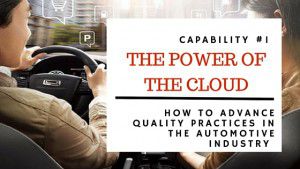How to advance quality practices in the automotive industry with cloud innovations

The vehicle is evolving from a mode of transport to being a platform for enabling a set of integrated experiences. What is enabling this transformation is technology. As new technologies are shifting the customer experience to the vehicle and changing the demands on quality, these advances also provide automakers with new tools to help manage the shift.
In my previous post, I looked at this transformation in more detail and outlined four new capabilities I wanted to share. We’ll begin with one of the most powerful in its ability to advance quality and the customer experience: cloud innovations.
Capability #1: The power of the cloud
One of the main roadblocks to innovation and business agility is, quite simply, the availability of technology infrastructure. It is difficult, time-consuming and costly to quickly add computing power at the same pace as a fast-moving, highly competitive industry.
The cloud removes this roadblock by providing connectivity and compute resources that are instantly available at huge scale. It is now possible for businesses to scale-up and out quickly, and to turn off capacity as soon as it is no longer needed, opening the door to a new set of capabilities across the business.
A great example of this is Delphi Automotive. It used the power of the cloud to transform its business model with connected-car services, offer richer features, reduce development costs (and pricing) by one-third and scale their service globally. Learn more here.
When cloud is introduced to more traditional product validation, like engineering simulation, it can radically change the speed of engineering and design validation. With high performance computing in the cloud for simulations, finite resources become unlimited and calculation times fall dramatically. Engineer idle time is eliminated as simulation jobs don’t have to wait, and team effectiveness is increased as many simulations can run in parallel.
In Microsoft’s own experience, we take advantage of the low-cost connectivity and limitless storage of the cloud to collect usage and performance data about our products and services, most consumed online, and use this data to identify issues that need to be addressed, as well as opportunities to advance the product itself.
That brings me to the second key component in this digital transformation: understanding how products and services are performing, and delivering a higher level of quality management through the important capabilities made possible by advanced analytics and machine learning. I’ll talk more about this in my next post.
LinkedIn: Chris Harries
Twitter: @chrisharauto




